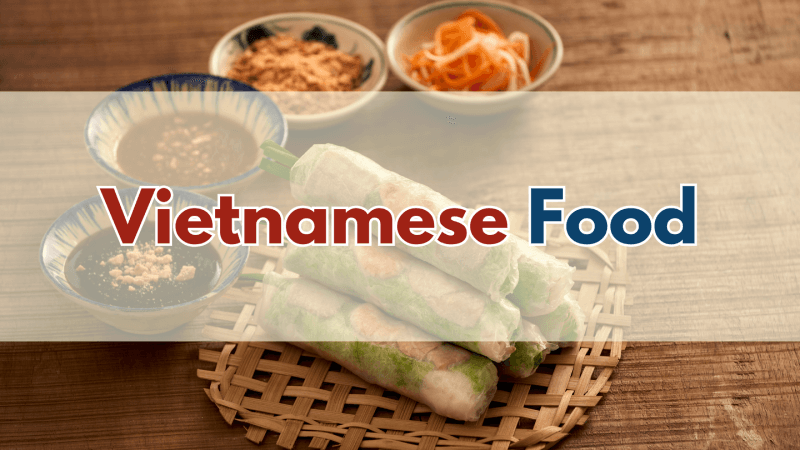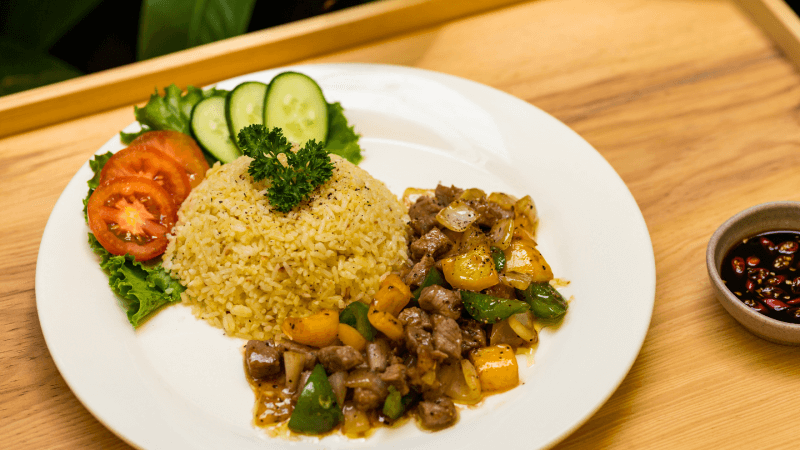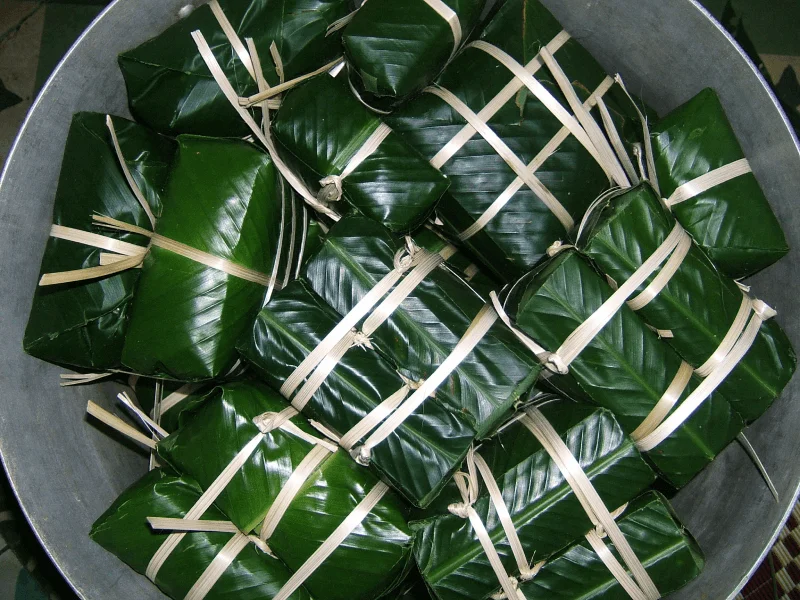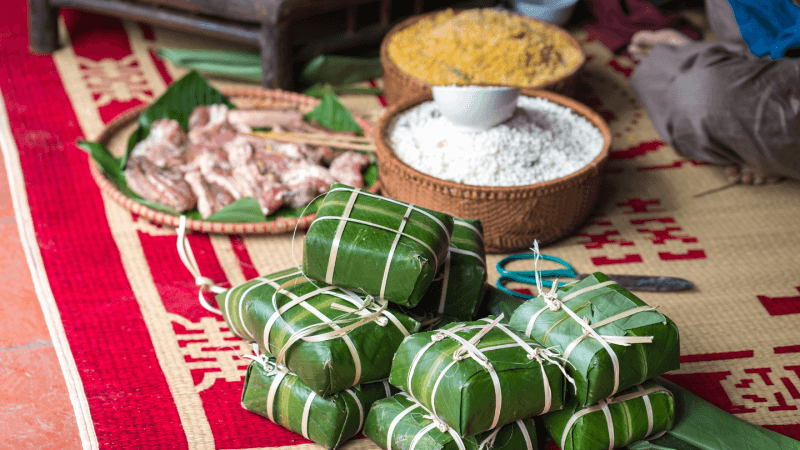Let’s dive into the world of Vietnamese food, where the focus is on fresh ingredients, lean proteins, and a bounty of herbs.
These components are not just about pleasure; they’re about fueling your body in a healthy way.
Vegetables and herbs like mint, cilantro, and Thai basil add a burst of flavour without piling on the calories.
The dishes are often lean because they rely heavily on fresh produce and seafood. This makes Vietnamese food a great choice if you’re looking to eat clean and green.

Nutritional Benefits of Vietnamese Food
Take Pho
For example, this steamy bowl of goodness is not just comforting but also packed with nutrients. The broth is usually simmered for hours, extracting collagen and minerals from the bones.
It’s no wonder that a bowl of Pho can be a one-stop shop for protein, vitamins, and minerals. Add some greens, lime juice, and chili, and you’ve got a meal that’s as balanced as it is delicious.

Goi Cuon
Also known as Vietnamese spring rolls. Typically wrapped in rice paper and stuffed with a mix of shrimp or pork, vermicelli noodles, and leafy greens, these rolls are low in calories but high in flavour and nutrition.
Dip them in a peanut sauce, and you’ve got a snack or light meal that’s fulfilling in every sense of the word.

Common ingredients
Now, let’s talk about some common ingredients. You can’t discuss Vietnamese cuisine without mentioning rice.
Whether in the form of noodles or as a staple side, rice is a critical source of carbohydrates. It’s usually paired with lean proteins like chicken or seafood, creating a meal that’s both filling and energy-boosting.

Vegetables like bok choy, cucumbers, and bean sprouts are often used, offering fibre and a good dose of vitamins A and C.
Spices and herbs also play a key role. Ginger and garlic are commonly used, both known for their anti-inflammatory properties. Each ingredient chosen in Vietnamese cooking often contains beneficial nutrients that contribute to a balanced diet.
Fermented foods, like fish sauce and pickled vegetables, are a significant part of the diet, adding probiotics that aid digestion. Fish sauce, a staple in almost every Vietnamese dish, is rich in B vitamins and omega-3 fatty acids.
When you mix these elements, the resulting flavour profile is not just tasty but also packed with health benefits.
Soups and Broths
Don’t forget the soups and broths. These are loaded with flavour without being heavy. A traditional Vietnamese broth provides hydration, protein, and minimal calories, making it a wholesome choice for a meal or a snack.
Seafood
Let’s also talk about the role of seafood. Being a coastal country, Vietnam makes excellent use of fish and shellfish. These marine ingredients provide healthy omega-3 fatty acids, known to benefit heart health.

To wrap it up, the nutritional benefits of Vietnamese food are all about balance and variety.
With its rich and diverse ingredients, Vietnamese cuisine manages to be both exciting and wholesome. It invites you to enjoy a meal that’s as good for your body as it is for your taste buds.
Whether you’re enjoying Pho, spring rolls, or a hearty stir-fry, you’re giving your body a delightful mix of nutrients. It truly is a cuisine that celebrates health as much as it does flavour.
Vegan and Vegetarian Vietnamese Options
Vietnamese cuisine offers a delightful variety of dishes that are both flavorful and plant-based, making it a paradise for vegans and vegetarians.
Traditional plant-based dishes like “Bánh Xèo,” a crispy pancake stuffed with mung beans and mushrooms, are a must-try.
Then there’s “Chả Giò Chay,” vegetable spring rolls packed with delicious greens and served with a tangy dipping sauce.
With so many plant-based options, it’s easy to explore Vietnamese cooking without missing out on its vibrant flavours.

For those interested in adapting popular dishes to be vegan, it’s simpler than you might think. Take the popular “Pho” soup: just swap the beef broth with a hearty vegetable broth and top it off with tofu instead of meat.
Similarly, “Bún Chay” is a vegetarian version of the classic vermicelli noodle bowl, which uses tofu or tempeh alongside fresh herbs and vegetables. The result? You still get that rich, aromatic experience, just without any animal products.
Vegetables
Vegetables and herbs are at the heart of Vietnamese cuisine. From crunchy cucumbers to fragrant basil, these ingredients add freshness to every dish.
“Rau Muống Xào Tỏi,” for instance, is a simple yet savoury dish of stir-fried morning glory with garlic, highlighting how Vietnamese cooking embraces vegetables. Whether you’re vegan or just love to eat your greens, you’ll find no shortage of vegetable-centric dishes to enjoy.
Herbs
Herbs also play a crucial role in Vietnamese food, offering more than just a burst of flavour. Mint, cilantro, and coriander are often used fresh, adding layers of taste and aroma to each meal.
These herbs, alongside fresh vegetables, form the backbone of many Vietnamese recipes. With their vibrant colours and distinct tastes, they bring life to even the simplest of dishes, encouraging a healthy and varied diet.

Exploring vegan and vegetarian Vietnamese food means diving into a world where every bite is exciting. The cuisine’s reliance on fresh, flavorful ingredients makes it naturally suited for those who prefer plant-based diets.
Whether you’re enjoying the subtle crunch of fresh rolls or savouring the warmth of a hearty noodle soup, vegan and vegetarian Vietnamese dishes promise a rich culinary experience. So, pull up a chair and let your taste buds savour the wonderful world of Vietnamese food, completely animal-free!
Vietnamese Cuisine: History and Culture
Vietnamese cuisine is not just about delicious food; it’s a culinary journey through history and culture.
Before the French arrived in Vietnam in the 19th century, the country’s food scene was a vibrant mix of local traditions.
The locals embraced fresh, tropical ingredients like rice, fish, and a wide variety of fruits and vegetables. This was a land where meals were simple yet flavorful, focusing on natural and unprocessed elements.
French colonisation left a lasting impact on Vietnamese food. The French introduced new ingredients and cooking techniques that mixed seamlessly with the traditional Vietnamese flavours.
Think of the popular bánh mì sandwich; it combines a crunchy French baguette with Vietnamese ingredients like pickled vegetables and fresh herbs. This fusion created unique dishes that continue to excite taste buds around the world.

Vietnamese Food: Regional Diversity
The influence on Vietnamese cuisine extends beyond French colonisation, drawing from regional diversity within the country itself.
Northern Vietnam, often characterised by its cold climate, focuses on subtle, mild flavours, with herbs playing the starring role.
Central Vietnam is known for its spicy dishes, often vibrant in appearance and bold in taste.
Meanwhile, Southern Vietnam offers food that’s sweeter and heavily relies on seafood. Each region contributes different ingredients and cooking styles, painting a delicious picture of Vietnamese food.
Food in Vietnam goes beyond sustenance; it’s deeply rooted in culture. Festivals and family gatherings are filled with dishes that symbolise happiness, prosperity, or remembrance.
An example is “bánh chưng,” a glutinous rice cake commonly eaten during Tết, the Vietnamese New Year, symbolising the earth and is believed to bring prosperity for the coming year.

These culinary traditions offer a glimpse into the values and beliefs of the Vietnamese people.
Another significant aspect is the practice of communal dining, where meals are shared among family and friends.
This tradition highlights the importance of harmony, a concept that also extends to the balance of flavours, colours, and textures in every dish. Food is not just consumed; it’s a shared experience that brings people together, evoking a sense of belonging and community.
In Vietnam, food is a sensory experience, bursting with various textures, tastes, and smells. There’s the comforting smell of broth bubbling away on a stove, the vibrant colours of fresh herbs and spices, and the satisfying crunch of a perfectly fried spring roll. Every ingredient tells a story, offering insights into the rich culture and history of Vietnam.
To truly appreciate Vietnamese cuisine, one must understand its origins and cultural significance. It’s a delightful blend of history and tradition, seasoned with regional influences.
So the next time you take a bite of Pho or savour a bánh mì, remember, you’re not just enjoying a meal—you’re partaking in a vibrant cultural legacy. Vietnamese food invites you to explore its past, engage with its present, and savour a shared future.
Vietnamese Dining Etiquette and Customs
Dining in Vietnam is an experience that goes beyond just eating. At the heart of it is communal dining, an essential part of Vietnamese culture. Meals are shared among family and friends, with dishes placed in the centre of the table for everyone to enjoy. It’s more than just filling your stomach; it’s about connection and sharing stories, laughter, and time with one another.
When you sit down for a meal in Vietnam, you’ll notice that it’s customary to wait for the eldest person to start eating before you dig in. It shows respect, one of the pillars of Vietnamese culture. Chopsticks are the main utensil, and it’s a fun skill to master. Just remember, don’t stick them upright in your bowl of rice—that’s considered bad luck and is a big no-no.

Different regions in Vietnam have their unique dining practices, reflecting their distinct cultural nuances. In the north, meals tend to be more formal, echoing the influence of ancient traditions.
In contrast, the south, known for its warmth and hospitality, embraces a more relaxed dining approach. Central Vietnam often features spicy dishes that entice you to savour slowly, adding a fiery twist to the dining experience.
As you enjoy Vietnamese cuisine, it’s wise to be mindful of a few dining taboos. Aside from the chopstick faux pas, finishing all the rice in your bowl is encouraged as leaving leftovers might suggest dissatisfaction with the meal.
It’s also polite to offer and share food with others at the table before serving yourself. These practices ensure that dining remains a harmonious and joyful occasion.
In Vietnam, dining is more than just food; it’s a lively celebration of flavours, family, and tradition. So, wherever you find yourself enjoying a bowl of Pho or savouring spring rolls, remember these little customs.
They are the spices that flavour the rich tapestry of Vietnamese dining, making every meal a memorable and heartwarming adventure.
Cooking Techniques of Vietnamese Cuisine
Vietnamese cuisine can take you on an exciting culinary adventure thanks to its wide range of techniques and flavours. Let’s start by talking about some popular preparation methods. Stir-frying is a go-to technique that brings out the flavours of vegetables and proteins by cooking them quickly over high heat.
This method retains the vibrant colours and crisp textures that are characteristic of Vietnamese dishes. Steaming, on the other hand, is commonly used for preparing delicacies like Bánh Bao or fish dishes, ensuring that flavours are locked in while keeping the meal light and healthy.
Another unique technique is the art of wrapping and rolling, famous in dishes like Goi Cuon or Banh Xeo. Here, fresh ingredients are encased in rice paper wrappers or thin, crispy pancakes. This method highlights the freshness of the ingredients and offers a beautiful blend of textures, from crunchy to smooth.
Let’s not forget the central role of grilling. Dishes like Nem Nướng use this method to bring out smoky flavours, accentuating the natural sweetness of meats or tofu through a simple yet effective technique.

When it comes to ingredient selection, freshness is key in Vietnamese cooking. Whether it’s picking out the freshest herbs or choosing the right cuts of meat, these choices play a crucial role in achieving that authentic taste.
Traditional markets in Vietnam are the perfect places to find the freshest produce. Vibrant displays of colourful fruits, vegetables, and aromatic herbs greet you and inspire the creation of delicious, wholesome meals.
If you’re cooking Vietnamese cuisine at home, your local Asian market can be a treasure trove of ingredients like fresh lemongrass, Thai basil, and lime, which are indispensable to many Vietnamese dishes.
Speaking of authenticity, mastering a few recipes and cooking tips can make a world of difference. Start small with a simple dish like Pho. The key to a flavorful broth is to simmer the bones for hours, allowing the essence to infuse into the liquid. Patience is everything here.
When adding spices like star anise or cinnamon, doing so slowly will ensure a balanced flavour. For stir-fried dishes like Rau Muong Xao Toi, timing is crucial. Quick, high-heat cooking keeps your vegetables crisp and your garlic fragrant, making the dish shine.

For those keen on experimenting with Vietnamese flavours, improvisation is welcome. Don’t shy away from adjusting recipes to suit your taste or available ingredients. If you can’t find a traditional ingredient, substitutes such as using soy sauce instead of fish sauce or sweet basil in place of Thai basil can work in a pinch. The spirit of Vietnamese cooking embraces innovation, so feel free to get creative in the kitchen.
To round off your culinary adventure, consider the role of seasoning and balance. Key condiments—like Nuoc Mam or fish sauce—bring an umami richness to plates, while fresh lime and chili add zest and heat. Harmony in flavors is a guiding principle in Vietnamese cuisine. Strive to balance sweet, sour, salty, and bitter tastes in your creations, ensuring each bite is an immersive culinary experience.
In sum, Vietnamese cooking is about precision, passion, and a touch of improvisation. Whether you’re crafting bowls of aromatic Pho or assembling fresh spring rolls, these techniques and tips will help you capture the vibrant world of Vietnamese cuisine in your kitchen. So, grab your chopsticks or spatula and head on a delightful culinary journey—Vietnamese style!
Beverage Pairings
Dive into a world of flavours with Vietnamese beverages that perfectly complement the cuisine. Traditional tea is a staple, with varieties like lotus tea offering a fragrant accompaniment to lighter dishes. The earthy taste harmonises with the freshness of Vietnamese herbs, creating a balanced dining experience. It’s not just about quenching thirst; it’s about enhancing every bite on your plate.
Vietnamese coffee is another must-try, particularly with its distinct preparation style. Strong and sweetened with condensed milk, this coffee delivers a rich flavour that pairs well with sweet treats like bánh flan or coconut desserts. A sip of this brew provides a delightful contrast to spicy dishes, making it a versatile choice that suits any meal.

Delve further into Vietnam’s ethnic beverages, like nước mía, a refreshing sugarcane juice that’s perfect for hot days. And let’s not forget fresh coconut water straight from the coconut! These drinks don’t just quench your thirst; they add a new dimension to your dining experience. Whether you’re enjoying a comforting tea, bold coffee, or a cool glass of juice, these Vietnamese drinks invite you into a vibrant world of flavours.
Culinary Destinations in Vietnam
Vietnam is a treasure trove for food lovers, with cities where unique flavours and culinary traditions come alive. Let’s start in Hanoi, the capital city. Known for its rich history and culture, Hanoi is a haven for foodies. Here, you can slurp a steaming bowl of Pho on a chilly morning or enjoy “Bun Cha,” a dish of grilled pork and noodles that’s famous for delighting even former U.S. President Barack Obama. Street vendors serve up delicious treats, making every corner feel like a new culinary discovery.
Next up is Ho Chi Minh City, formerly known as Saigon. This bustling metropolis is where traditional Vietnamese cuisine meets a modern twist. Picture savouring a “Banh Mi” sandwich packed with savoury pork, pate, and fresh vegetables, all tucked inside a crispy baguette. The city’s vibrant food scene also includes bustling markets and chic eateries, offering everything from budget-friendly eats to upscale fusion dishes that surprise and delight.

Head north to savour the bold flavours of Hue. Famous for its imperial cuisine, Hue offers dishes that are as visually captivating as they are tasty. Here, you’ll find “Banh Beo,” delicate rice cakes topped with shrimp and crispy pork. It’s like eating a piece of art. In this city, food tells stories of royalty and tradition, giving you a taste of Vietnam’s grand history with every bite.
Finally, the coastal city of Hoi An is a must-visit for culinary adventurers. Known for its beautiful old town, Hoi An serves up iconic dishes like “Cao Lau,” a noodle dish unique to the area. Wander through lantern-lit streets and discover markets brimming with fresh ingredients. From Hanoi’s traditional allure to Hoi An’s coastal charm, Vietnam is a culinary journey waiting to be explored. Each city offers tastes you won’t want to miss!
Conclusion and Final Thoughts
Exploring Vietnamese cuisine is like embarking on an exciting adventure rich with flavours and traditions. You’ve discovered a world where balance is key, from aromatic bowls of Pho to fresh, zesty spring rolls.
The magic lies in its simplicity, with fresh ingredients and herbs creating vibrant dishes that tell stories of culture and history. It’s an experience that engages all your senses, with every bite offering a new taste sensation.
Vietnamese food is more than just a meal—it’s a celebration of life and a way to connect with others. Whether you gather around the table with family or try your hand at replicating dishes at home, you embrace a culinary tradition that’s all about sharing and enjoyment.
The beauty of Vietnamese cuisine is that it’s accessible and adaptable, allowing you to experiment while honouring its authentic roots.
